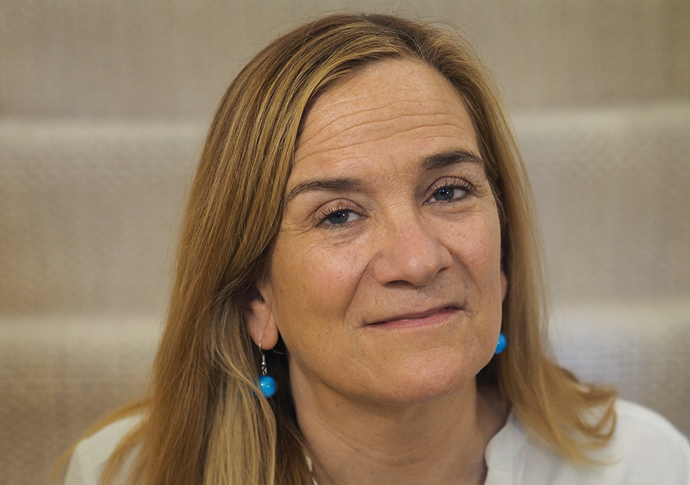Glass war
Charles Harris talks research and love of colour with novelist Tracy Chevalier
Thursday, 7th November 2024 — By Charles Harris

Tracy Chevalier [Jonathan Drori]
IN Tracy Chevalier’s last novel, A Single Thread, a woman contemplates Jane Austen’s grave and wonders how much she might achieve before she’s the age Austen died. With her 11th, The Glassmaker, Chevalier can have no such worries.
When I talked to her in her Dartmouth Park terrace house, she’s three days shy of her 62nd birthday on October 19 – and more interested in calculating how many novels she may have left.
This could also be an after-effect of Covid, which she’s just got over. But Covid has had its effect on The Glassmaker in a number of ways – surprising, considering the novel opens in 15th century Venice.
It’s 1486 and we’re following the Rosso family, glassmakers on the Venetian island of Murano, and Orsola Rosso, desperate to enter the man’s world of glassmaking.
Like many of Chevalier’s novels, the story focuses on the making of things, from cathedral kneelers to, famously, Vermeer’s paintings in her breakout novel Girl with a Pearl Earring. Around five years ago, inspired by a suggestion from an Italian reader, she began to research Venetian glass trade beads.
Unlike the more showy glassware, beads were “made by women,” she says, “sitting at their kitchen tables over a little lamp”. This appealed to her – not as an imposed 21st-century feminism but as a way of exploring a woman trying to find her own way.
The book also focuses on family. When the head of the family, maestro glassmaker Lorenzo dies unexpectedly, Orsola’s brother Marco ascends to chief glassmaker. But he’s too young. His inexperience and his pig-headed refusal to accept Orsola’s glass bead work form one main strand of the novel.
Almost worse, Orsola falls heavily for a fisherman from the main island of Venice. Murano glassmakers don’t socialise with fishermen or Venetians, despite the city being only a few minutes away by gondola. Orsola’s problems mount.
This is a saga, but an unusual one. Time skips on, like a stone skipping across the Venetian lagoon, but in a strange kind of Murano time-warp, the Rosso family and their associates age more slowly than the outside world. In shades of Virginia Woolf’s Orlando, Orsola’s life spans five centuries. World events and real-life celebrities come and go – the bubonic plague, Casanova, Napoleon, the First World War, even the Covid pandemic. Orsola lives through it all, fighting furiously for her trade and her love, and fighting to get her brother to respect her work.
This grand sweep came in part from Tracy’s experience of lockdown. “Our sense of time shifted,” she says. “The things we set time by were missing. Some times felt really short and some really long. So maybe I felt I could play with time more as a result.”
Does it work? Yes. She draws us powerfully into a web of engaging relationships. The emotional heart of the book lies in Orsola’s friendships, those who support her – and sometimes fail her. In particular, though not exclusively, the women.
Tracy’s career began as a reference book editor, where she says: “I learned how to research, to use libraries and to write my notes so that I could actually read them.” Not just libraries. For The Glassmaker she made many trips to Venice, studied its history and learned glassmaking for herself.
But she wears her research lightly, inspired as much by her love of being there, seeing, as she tells me, “the sun on the buildings and what the water smelled of”.
In part this comes from her time studying creative writing at the University of East Anglia. (Her application was prompted by reading an article by Kentish Town-based author Louise Doughty). It was there that she “learned to write a better sentence. It’s like practising the piano. You put the time in.”
Tracy is one of the best authors alive at evoking the challenges, frustrations and exhilarations of creation. Central to this is her love of colour. It runs through her work from the very title of her first novel – The Virgin Blue – to descriptions of Vermeer’s paintings to the thread of the “broderers” in A Single Thread. The descriptions of Venetian glassware are sumptuous with the glow and sparkle of glass goblets, necklaces, chandeliers, trinkets in all colours of the rainbow.
When I ask where this love of colour came from, Tracy is unusually stopped in her tracks. “My father,” she says finally. “He was a photographer for the Washington Post and his photos were all in black and white, because that’s what newspapers used then. So maybe I’m trying to colour them in. I’ve never thought of that before. Like a newspaper, I have real people, but I make up people and I weave them together. Weaving real and fictional together, but with colour added.”
• The Glassmaker. By Tracy Chevalier. Harper Collins, £20
• Charles Harris’s Camden-set psychological thriller novel Room 15 is out now from Bloodhound Books